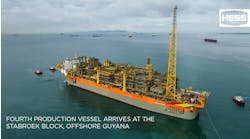Woodside Petroleum Ltd. continues work on the $761-million Vincent oil development, targeting first production by 2008. This follows a successful production start at nearby Enfield in July.
The Vincent project, which received joint venture financial approval in March 2006 and commonwealth government environmental approval in June 2006, has about 73 MMbbl of oil reserves. It was discovered December 1998 in deepwater license WA-28-L off North West Cape, Western Australia.
As of the end of August 2006, the project was 13% complete, according to the operator.
Full field development of Vincent will be undertaken in phases, with future phases based on technical success of the initial phase and greater certainty about the extent of the Vincent oil reservoir.
The initial phase is planned to comprise a double-hull, disconnectable FPSO linked to eight production and three reinjection wells. It is similar to the Enfield development where water and gas are reinjected into the reservoir for environmental reasons.
The FPSO for Vincent will start with the conversion of an oil tanker,Ellen Maersk, at Singapore’s Keppel shipyard. The FPSO will be given an Aboriginal name out of respect for current and past Aboriginal elders of the region, Woodside says.
Other major activities off North West Cape are planned for late 2006, with the start of drilling of the development wells. The drilling rig will be theNan Hai VI. Maersk Contractors Australia will operate the rig for about 18 months using an Australian crew. Woodside operates the field with 60% of the concession rights while Japanese-owned Mitsui E&P Australia Ltd. has the remaining 40%.
At the $1.1-billion Enfield project, Woodside recently completed the hookup, testing, and commissioning of the FPSO, namedNganhurra, meaning “we all” in the Thalanyji Aboriginal language. Production was increasing steadily at Nganhurra, 50 km (31 mi) northwest of Exmouth in a water depth of 390 m (1,280 ft). It is designed to handle a maximum production of 100,000 b/d of oil and to store 900,000 bbl of oil. Nganhurra is 38 km (24 mi) north of the cape, 50 km (31 mi) north of Exmouth, and 20 km (12 mi) north of the boundary of the Ningaloo Marine Park. Enfield, discovered in April 1999 in license WA-28-L, has estimated reserves of 127 MMbbl of oil.
Woodside developed an oil production facility with features that have set the standard for projects to follow, including the development of the nearby Stybarrow field. Oil, water, and gas are extracted from beneath the seabed and piped to theNganhurra for separation and treatment. Gas and water are reinjected, and the oil is stored in tanks in the vessel’s double hull. Oil is produced from five wells, while the separated water and gas are reinjected using six and two wells, respectively. The FPSO, scheduled to be stationed at Enfield for 12 years, can disconnect from its mooring and sail away in the event of harsh weather. The vessel has a speed of 12 knots, should it need to leave station. South Korea’s Samsung Heavy Industries built the 142,000 dwt FPSO, which is 260 m (853 ft) long, 46 m (151 ft) wide, and has 18.2 m (60 ft) draft. About 20 people work on the vessel.
TheNganhurra’s first oil cargo departed on Aug. 14 on the Rainbow River oil tanker for delivery to Australian refineries. Plans called for six cargoes to have loaded by the end of September. The off-take frequency during the early years of production will be four or five cargoes a month, says Woodside, with off-take frequency reducing in line with the natural decline of the resource.
The start of production at Enfield follows consultation over many years with community, industry, and government representatives. Input from many individuals and groups in Perth and Exmouth played a significant role in Woodside’s decision on the design ofNganhurra, and has provided feedback to Woodside to minimize potential impacts on local recreational and business activities.
Nganhurra Operations Manager, Kevin Howard says that Woodside has invested time and resources to understand the deepwater operating environment, to develop operating systems appropriate for the area, and to bring together an operations team with experience and commitment, since the first oil discovery off North West Cape in 1997.
“A lot of people in Woodside have been involved in the development of the Enfield oil field, from exploration to drilling, and from development to operations,” Howard says. “Going forward, we have a first-class facility and a crew that is committed to maintaining safe and reliable production, and minimizing environmental impact.”
Meanwhile, the $600-million Stybarrow oil field development off the northwest coast of Australia involves a subsea development and another FPSO facility with a gross capacity of 80,000 b/d of liquids. The first subsea system was received and drilling of the first well began 3Q 2006. Stybarrow’s first production is expected during 1Q 2008, five years after discovery in February 2003 in permit WA-255-P.
BHP Billiton is the operator with 50:50 concession rights in partnership with Woodside.
Gurdip Singh, Special Correspondent






